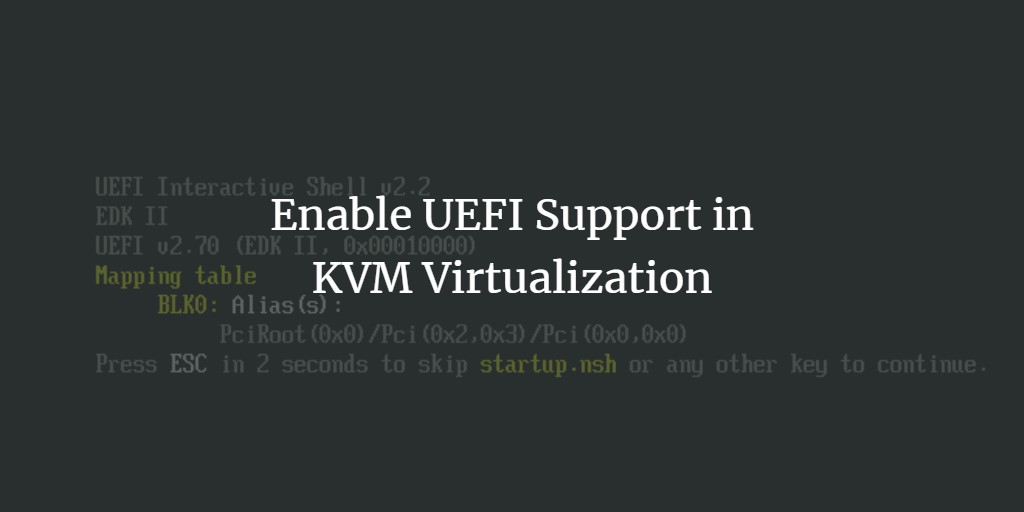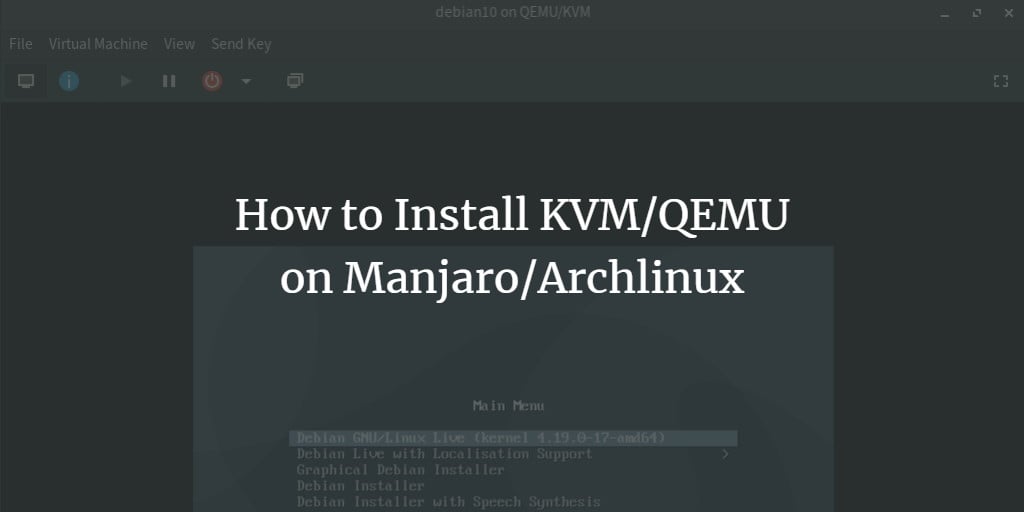Linux Tutorials on the topic “kvm”
-
Enable UEFI Support in KVM Virtualization
Author: Arvid L • Tags: kvm, linux, virtualization • Comments: 0UEFI or Unified Extensible Firmware Interface is considered as the firmware replacement for BIOS. It comes with more features and functionality that are limited on BIOS, and it is available on nowadays motherboards and modern PCs.
-
How to Install KVM/QEMU on Manjaro/Archlinux
Author: Arvid L • Tags: arch linux, kvm, linux, server • Comments: 3In this guide, you will learn how to set up KVM/QEMU virtualization on Manjaro/Archlinux machine. Also, you will learn how to create the first virtual machine with the GUI application "virt-manager" - a desktop user interface for managing virtual machines.
-
How to Install Proxmox VE 4 on Debian 8 (Jessie)
 Author: Muhammad Arul •
Tags: debian, kvm, linux, server, virtualization •
Comments: 8
Author: Muhammad Arul •
Tags: debian, kvm, linux, server, virtualization •
Comments: 8 Proxmox Virtual Environment or short Proxmox VE is an Open Source server virtualization software based on Debian Linux. In this tutorial, I will show you the installation of Proxmox on a server that runs a minimal Debian 8 installation, e.g. in a datacenter.
-
-
Installing Virtualizor on CentOS 6.5 with RAID1
 Author: kuso89 •
Tags: linux, virtualization, centos, control panels, kvm, openvz, xen •
Comments: 0
Author: kuso89 •
Tags: linux, virtualization, centos, control panels, kvm, openvz, xen •
Comments: 0 Installing Virtualizor on CentOS 6.5 with RAID1 This guide covers installing the Virtualizor control panel on CentOS 6.5 with RAID1.
-
Virtualization With KVM And openQRM 5.1 On Debian Wheezy
 Author: openQRM •
Tags: debian, kvm, virtualization •
Comments: 0
Author: openQRM •
Tags: debian, kvm, virtualization •
Comments: 0 Virtualization With KVM And openQRM 5.1 On Debian Wheezy This HowTo is about how to create and manage KVM Virtual Machines on Debian 7 aka Wheezy with openQRM 5.1.
-
Virtualization With KVM On A CentOS 6.4 Server
 Author: Falko Timme •
Tags: virtualization, centos, kvm •
Comments: 11
Author: Falko Timme •
Tags: virtualization, centos, kvm •
Comments: 11 Virtualization With KVM On A CentOS 6.4 Server This guide explains how you can install and use KVM for creating and running virtual machines on a CentOS 6.4 server. I will show how to create image-based virtual machines and also virtual machines that use a logical volume (LVM). KVM is short for Kernel-based Virtual Machine and makes use of hardware virtualization, i.e., you need a CPU that supports hardware virtualization, e.g. Intel VT or AMD-V.
-
Virtualization With KVM On A Scientific Linux 6.3 Server
Author: Falko Timme • Tags: kvm, linux, virtualization • Comments: 0Virtualization With KVM On A Scientific Linux 6.3 Server This guide explains how you can install and use KVM for creating and running virtual machines on a Scientific Linux 6.3 server. I will show how to create image-based virtual machines and also virtual machines that use a logical volume (LVM). KVM is short for Kernel-based Virtual Machine and makes use of hardware virtualization, i.e., you need a CPU that supports hardware virtualization, e.g. Intel VT or AMD-V.
-
Installing KVM Guests With virt-install On Ubuntu 12.10 Server
 Author: Falko Timme •
Tags: kvm, ubuntu, virtualization •
Comments: 0
Author: Falko Timme •
Tags: kvm, ubuntu, virtualization •
Comments: 0 Installing KVM Guests With virt-install On Ubuntu 12.10 Server Unlike virt-manager, virt-install is a command line tool that allows you to create KVM guests on a headless server. You may ask yourself: "But I can use vmbuilder to do this, why do I need virt-install?" The difference between virt-install and vmbuilder is that vmbuilder is for creating Ubuntu-based guests, whereas virt-install lets you install all kinds of operating systems (e.g. Linux, Windows, Solaris, FreeBSD, OpenBSD) and distributions in a guest, just like virt-manager. This article shows how you can use it on an Ubuntu 12.10 KVM server.
-
Virtualization With KVM On Ubuntu 12.10
 Author: Falko Timme •
Tags: kvm, ubuntu, virtualization •
Comments: 2
Author: Falko Timme •
Tags: kvm, ubuntu, virtualization •
Comments: 2 Virtualization With KVM On Ubuntu 12.10 This guide explains how you can install and use KVM for creating and running virtual machines on an Ubuntu 12.10 server. I will show how to create image-based virtual machines and also virtual machines that use a logical volume (LVM). KVM is short for Kernel-based Virtual Machine and makes use of hardware virtualization, i.e., you need a CPU that supports hardware virtualization, e.g. Intel VT or AMD-V.
-
Virtualization With KVM On An OpenSUSE 12.2 Server
 Author: Falko Timme •
Tags: virtualization, suse, kvm •
Comments: 1
Author: Falko Timme •
Tags: virtualization, suse, kvm •
Comments: 1 Virtualization With KVM On An OpenSUSE 12.2 Server This guide explains how you can install and use KVM for creating and running virtual machines on an OpenSUSE 12.2 server. I will show how to create image-based virtual machines and also virtual machines that use a logical volume (LVM). KVM is short for Kernel-based Virtual Machine and makes use of hardware virtualization, i.e., you need a CPU that supports hardware virtualization, e.g. Intel VT or AMD-V.


